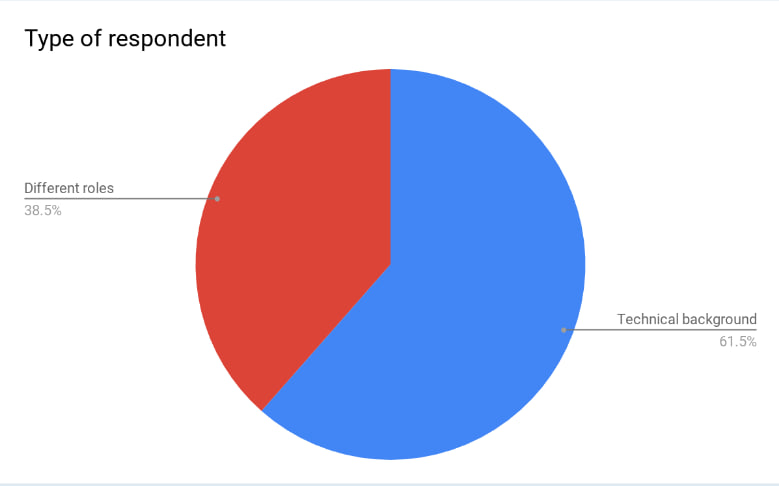This is the seventh post of the “Marketing an Open Source Project” series. This blog entry reveals insights from a survey on open-source software (OSS) community marketing. If you haven’t read the first article, you can find it here.
Interview results
The interview that was distributed online gathered a total of thirteen respondents. Firstly, I will present the raw data obtained from the surveys, and afterwards, the data and its results are analysed and interpreted. This allows readers to examine the thought process behind research decisions and minimizes the chance of researcher bias being embedded in the research method without transparency.
Participants’ ages ranged from 28 to 57 years with 100% identified as males. 61.5% of the participants have a technical background, and their main role in the OSS community is contributing code. The remaining 38.5% have different roles, such as business owners, consultants, implementors, and functional users. A significant number of respondents (53.8%) benefit directly from the OSS project by using the software in their companies, working around paid services on the project, having the project as the backbone of their products, etc. The interviewees are or have been members of thirteen different OSS projects. The respondent’s gender is not a relevant factor in the research, so the fact that women are not represented is not harmful to the research. The demographical data is not analysed in this research since the focus is on the community members’ opinions on marketing rather than looking at individual segments.

The author invited members of different OSS communities to answer the survey, and the interview was open and accepted responses for 6 months. These OSS communities have a considerably large number of active users [1], from which only seven persons participated in the study proactively. I approached the remaining six directly, indicating a lack of interest in the topic within OSS communities.
Furthermore, a large number of respondents showed or expressed a feeling of apathy towards marketing within the OSS communities. Many of the interviewed developers thought marketing is not important, unnecessary or held a bad image of doing marketing, sometimes finding the topic awkward, unnatural or counterintuitive for open-source environments.
The interviewees who did not have a technical role within the communities were more open towards the topic. There is a general feeling within this segment that as OSS community projects are driven by developers, it is too hard to arouse interest or even bring up the topic. These members are usually business owners or consultants, which can be identified as a clear reason why the topic is more interesting to them, as they are more familiar with it. However, the motives behind these users can also be seen as a threat. They tend to think more about marketing with the simple purpose of facilitating the selling tasks and generating revenue, instead of increasing brand awareness, which might be a reason for the resistance from the developers.
The purpose of marketing an OSS community-driven project seems to be clear in general: increasing brand awareness to attract more contributors, sponsors, and end-users. There is also a common belief that more end-users would attract more contributors. However, there is a distinction of the type of end-users in different projects, depending on the project’s nature; some projects are meant to be used by individuals, some by companies, some others by developers in other projects, etc.
Lack of resources is perceived as a big problem when thinking about marketing OSS community-driven projects, the main resources being funding, time and expertise. Most respondents agree that marketing an OSS community-driven project would be beneficial for all the stakeholders when done properly, except for a few members who would not like more competition within the communities. In terms of how increasing brand awareness could affect OSS community-driven projects, the perception is that it can only be helpful, as long as the project is good enough and willing to grow.
Some respondents validate what is found in the literature regarding the topic. Community members fear losing control when a company sponsors or gets involved too much in marketing efforts. In fact, two respondents left OSS projects due to marketing mismanagement. One project, after securing venture capital, closed its source code, prompting mass exits. Another project did marketing behind the backs of the majority of the community, and their goals conflicted with those of the top contributors. This in the end led the top contributors to create their own project and leave. Hence, these community members tend to resist and be suspicious of marketing initiatives when they come from a company or a small group in which not everyone feels represented.
Among developers, there can be seen a misconception about marketing, often associating it with overpromising and exaggeration for sales.
“Marketing always end up promising non-existing features or exaggerating functionalities in order to sell”
J. Arboleda. Survey respondant 2018
However, when the respondents were asked about it differently, without explicitly mentioning the word marketing, their responses were mostly positive. They showed interest in wanting the project to grow, helping people become familiar with it, attracting more contributors, building brand awareness, and raising recognition of their efforts and results as a community.
“Perhaps we just need to use a different word. We may need to use community development or project advocacy as a word in the open-source realm as opposed to marketing, and perhaps then people will realize that they need to do it“
Nithya Ruff – TODO GROUP Marketing Open Source Projects
In summary, the following results were identified from the interviews:
- There is a lack of interest within OSS communities regarding marketing.
- Business owners and users who benefit directly from the OSS projects are more open towards the topic but their motivations might be seen as a threat within the communities.
- The purpose of marketing OSS community-driven projects seems to be clear in general, however, the target market might be different depending on the nature of the project.
- Lack of resources (time, funding and expertise) is a clear barrier to marketing.
- The goals of marketing are seen as beneficial among the majority of community members when performed properly.
- There is an identified threat of losing control over the project when a company, or a small group, sponsors or leads such initiatives.
- Transparency is key when marketing OSS community-driven projects; if the top contributors or the community perceive that decisions are being made behind their backs that might erode the project’s image and they might leave.
- Among developers there is a misconception of the term marketing, most of them see it as a way to sell the project which causes a high resistance towards it.
Dive into the next section to explore the secondary data analysis conducted in the research. How do OSS community projects engage in marketing activities? How interesting is the topic? What are the key aspects when engaging in these activities? All of these questions and more will be addressed in the next post.
References:
[1] Pagano, D. & Maalej, W., 2012. How do open source communities blog?. Empirical Software Engineering, Volume 18, p. 1090–1124.

I am a systems engineer with a great passion for open source, software development, and technology in general. I have been part of the iDempiere community since 2012. I believe the enterprise world is one of the most aggressive environments out there. Companies tend to ruthlessly compete against each other. That is why seeing competitors co-exist and cooperate in harmony in iDempiere (and OSS communities in general) is so interesting to me.
